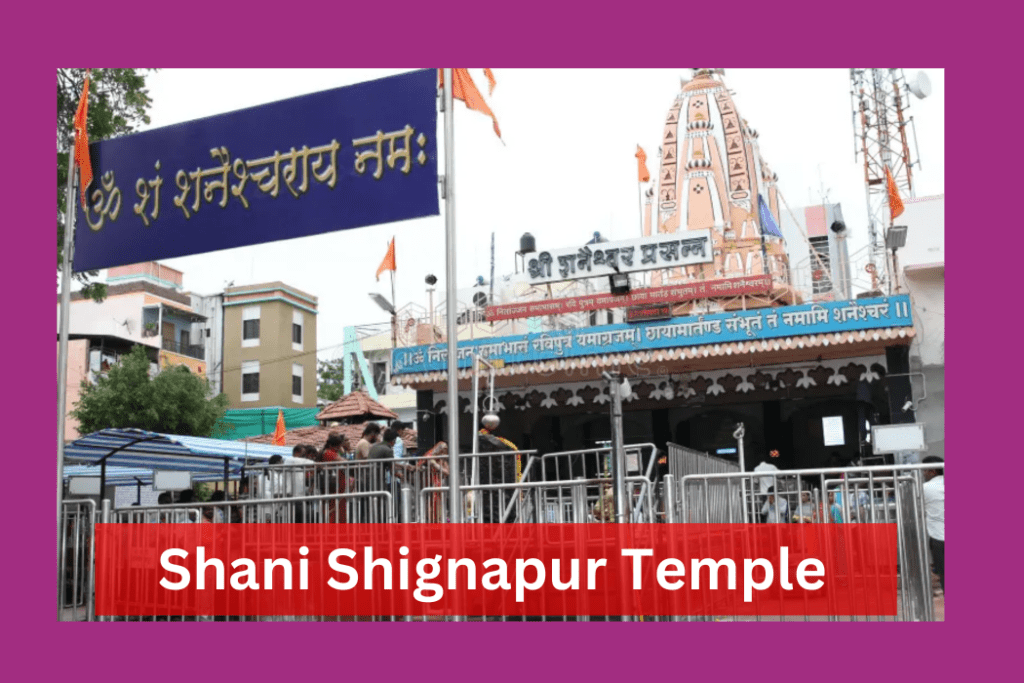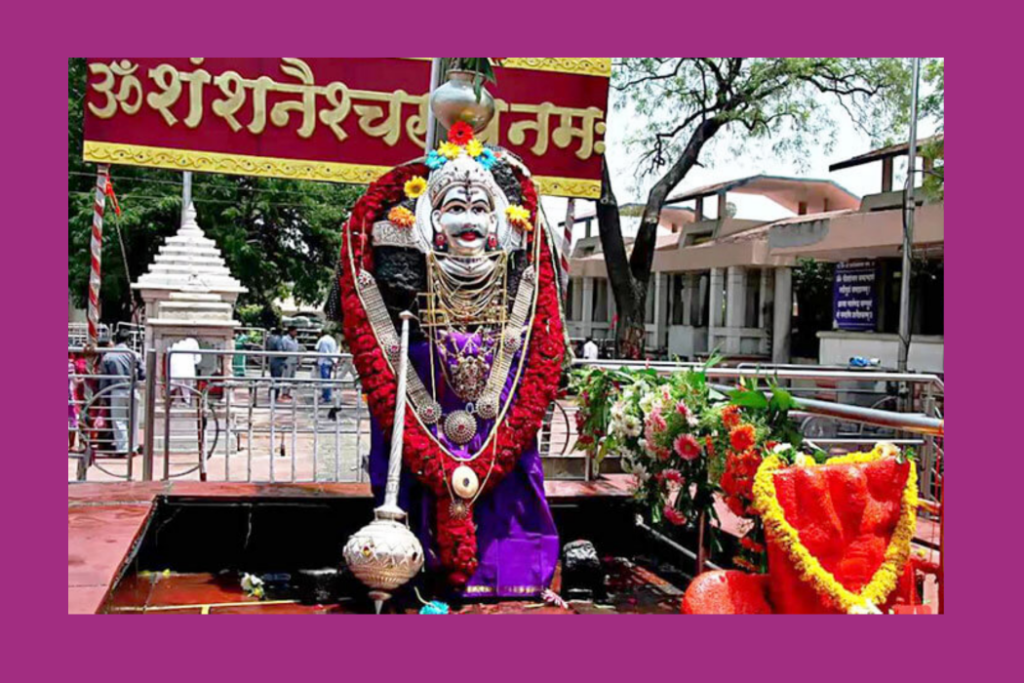Shani Shingnapur Temple, Maharashtra: History, Significance, and Travel

The temple at Shani Shingnapur is devoted to Lord Shani, a significant deity in Hindu religion. The temple is known as a “Jagrut Devasthan ”, signifying it is a living temple. This indicates that individuals have faith that Lord Shani continues to reside in this place!
The statue located in the temple is known as “Swayambhu”, which translates to “self-arisen”. This black stone statue is thought to have emerged from the ground at the start of Kali Yuga.
Going to the Shani Temple allows individuals to connect with Lord Shani and request his blessings. It is a location abundant in belief and reverence, creating a sacred atmosphere for all.
Now, we will explore the background and importance of this sacred Shani Shingnapur Temple.
| Participate in online puja organised by VAMA (Get the puja done with your name and gotra) | |
| Name of Puja | Temple (Place) |
| Rin Mukti Puja | Rin Mukteshwar Mahadev Temple (Ujjain) |
| Tantra Badha Mukti Bhairav Mahasuraksha Yagya | Vikrant Bhairav Mandir,Ujjain |
| Shani Sade Sati | Shani Shingnapur Devsthanam ,Maharashtra |
| Vyapar Vriddhi Mahalakshami Puja Evam 108 Kanak Stotra Path | Mahalakshmi Temple,Maharashtra |
| Rahu Grah Shanti Puja | Jarkutinatheshwar Mahadev Temple, Prayagraj |
| Rahu-Ketu Shanti Puja | Rahu Temple, Paithani, Uttarakhand |
Read this Blog to know about Alopi Devi Temple – Alopi Devi Mandir, Prayagraj: History, Significance, and Travel
History and Story Behind Shani Shingnapur Temple
As per the followers, a huge black stone was carried to the river’s edge by the monsoon rains one day near Shingnapur. A few kids playing close by tossed stones at the rock, and one of them struck it forcefully.
All of a sudden, the rock started bleeding and a loud wailing noise could be heard. The kids fled in terror, while the locals assembled to observe the situation. The sight of blood gushing from the rock astonished them, leading some to think it was a spirit or evil entity.
During the night, Lord Shani visited the village headman in a dream and revealed that the rock was his true manifestation. The chief was ecstatic, and the following day he shared his dream with the villagers.

The villagers respectfully brought the rock from the river back to the village. After placing it inside a temple, Shani Shingnapur became known as a sacred location.
Some people think that the village of Shingnapur has not had any theft or robbery cases since Lord Shani came. Shani Shingnapur has gained the moniker of the “village without doors” due to this very reason.
On a couple of occasions, thieves attempted to rob the village but without success. They got caught, faced consequences, and never came back.
The villagers of Shingnapur have faith that their village is safeguarded from crime by Lord Shani. They appreciate having him around, and they persist in worshipping him with dedication.
Architecture of Shani Shingnapur Temple
The design of the Shani Shignapur Temple is basic but special. In contrast to other temples, this temple lacks a sanctum sanctorum (garbhagriha) or an idol. Alternatively, it includes a spacious open-air platform with a sizable black stone situated on top. It is thought that the stone symbolises Lord Shani, the main deity of the temple.
The temple has no walls, giving worshippers a clear view of the sacred rock. It is believed that Lord Shani dwells in the black stone, and the temple’s design symbolises a space where worshippers can establish a direct connection with the deity.

Spiritual Significance and Festivals
Lord Shani, who embodies the planet Saturn in Hindu mythology, is a deity who is both intricate and highly respected. Frequently dreaded for his strict fairness, he is also highly respected for his influence on personality development, imparting knowledge, and acknowledging determination. The spiritual and astrological beliefs of Hinduism have deep connections to the festivals associated with him, such as Shani Jayanti, Shani Amavasya, and Shani Trayodashi.
Prior to exploring the festivals, it is crucial to comprehend the importance of Lord Shani. His duty in the universe is to uphold harmony and organisation as the offspring of Surya (Sun) and Chhaya (Shadow). Shani embodies karma by fairly giving out rewards and punishments according to one’s actions. It is believed that his power is strong, and as he moves through various zodiac signs, it is thought to create important changes in a person’s life.
Followers have faith that honouring Lord Shani on this day can reduce the adverse impacts of Saturn’s movement and draw his blessings. It’s a day to reflect, feel remorse, and ask for forgiveness for past errors. Devotees aim to bring about through prayers, fasting, and rituals.
How to Reach the Shani Shingnapur Temple?
Air travel: The nearest airports are located in Aurangabad (90 km distance), Nasik (144 km distance), and Pune (161 km distance). Take a taxi or use public transportation from these airports to reach the Shani Shingnapur Temple.
Taking the train: Rahuri is the nearest train station located 32 kilometres away. Ahmednagar (35 km), Shrirampur (54 km), and Shirdi Railway Station (75 km) are nearby stations.
MSRTC buses operate from key points in Maharashtra, offering convenient transportation through road access. Potential options include Shirdi, Rahuri, Ahmednagar, Pune, Vashi, and Mumbai.
Explore the sacred aura and religious importance of Shani Shingnapur Temple. Engage in the peaceful ambiance, admire the stunning architecture, and spiritual essence that this sacred temple offers.
Frequently Asked Questions
What is the significance of Shani Shingnapur Temple?
Lord Shani, who embodies the planet Saturn in Hindu mythology, is a deity who is both intricate and highly respected. Frequently dreaded for his strict fairness, he is also highly respected for his influence on personality development, imparting knowledge, and acknowledging determination. The spiritual and astrological beliefs of Hinduism have deep connections to the festivals associated with him, such as Shani Jayanti, Shani Amavasya, and Shani Trayodashi.
What is the story of Shani Shingnapur Temple?
As per the followers, a huge black stone was carried to the river’s edge by the monsoon rains one day near Shingnapur. A few kids playing close by tossed stones at the rock, and one of them struck it forcefully. All of a sudden, the rock started bleeding and a loud wailing noise could be heard. The kids fled in terror, while the locals assembled to observe the situation.
How is the Architecture of Shani Shingnapur Temple?
The design of the Shani Shignapur Temple is basic but special. In contrast to other temples, this temple lacks a sanctum sanctorum (garbhagriha) or an idol. Alternatively, it includes a spacious open-air platform with a sizable black stone situated on top. It is thought that the stone symbolises Lord Shani, the main deity of the temple.
Want to know about Bhimashankar Jyotirlinga? Read this blog – Bhimashankar Jyotirlinga, Pune: History, Significance, and Travel




